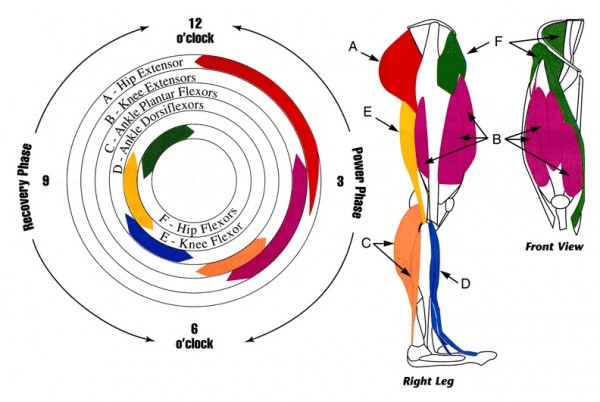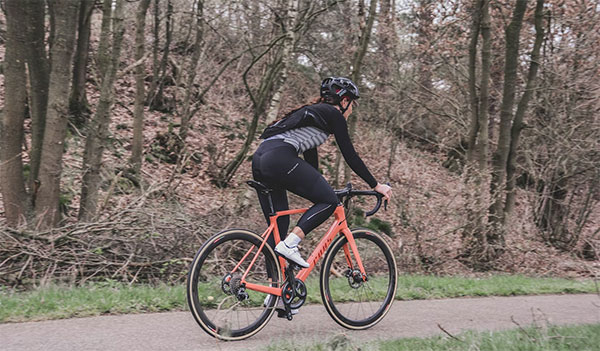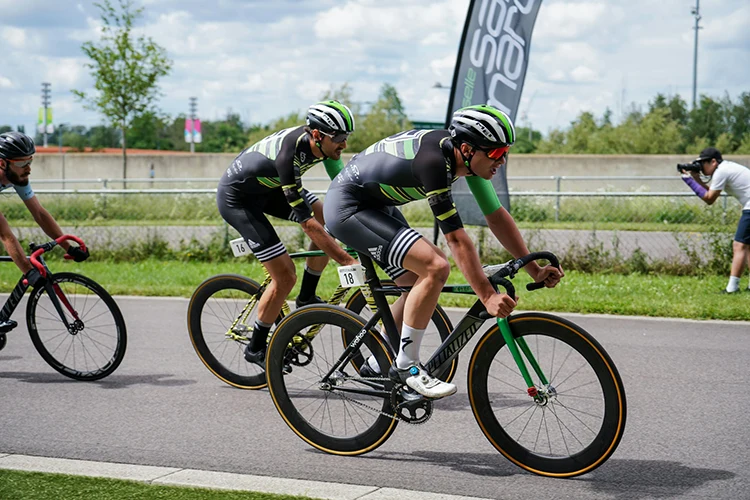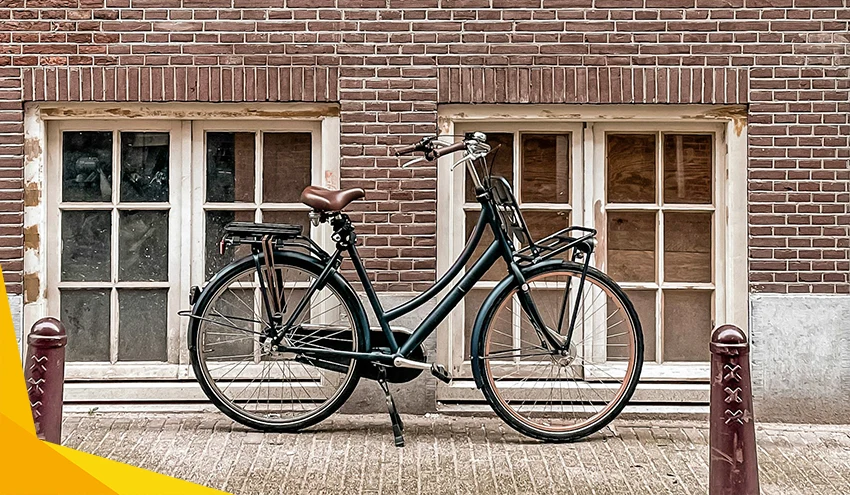Cycling is more than purely aerobic exercise. Your legs can get bigger, your abs more toned, and your arms can get stronger too. Every body shape is different, but cycling will certainly have an effect.
In this post, we’ll tell you everything you need to know about the effect of cycling on body shape.
When asked to picture a “cyclist,” a few images pop into people’s heads. You might picture a thin climber or a thick-legged sprinter in the Tour de France.
You could also picture an all-around built Classics rider who looks like they could be a professional athlete in any sport. Or you might picture a track sprinter whose quads are on the edge of splitting their shorts open.
Regardless of what type of cyclist you are, there is an effect of cycling on body shape.
While body shape doesn’t necessarily correlate with cycling performance, it is an important effect of cycling in your everyday life.
In fact, you might have to buy some new pairs of pants after cycling for a few months. Let’s explain.
What Muscles Are Used in Cycling?
Cycling is a non-weight-bearing aerobic activity that primarily utilizes the legs and cardiovascular system. But the sport is about much more than pedaling alone.
During cycling, you are using your legs, core, and arms, as well as countless other muscles used for balance and stabilization.
Leg Muscles

The primary muscles used in cycling are the lower body muscles, or legs.
With each pedal stroke, your quadriceps, hamstrings, glutes, calves, hips, and ankles push and pull on the pedals. The harder you ride, the harder these muscles are worked.
Cycling is effectively a low-impact form of resistance training. This helps you simultaneously burn fat and gain muscle mass, especially in your legs. However, you will need to ride at high intensities to gain a significant amount of muscle mass.
Cycling at low intensities is great for your fitness and cardiovascular health, but it will not help you gain a significant amount of strength in your leg muscles.
With harder training, your leg muscles will get stronger and more toned, meaning they will lose fat and add muscle.
The size and strength of your leg muscles primarily depend on your genetics and specific training. For example, some people are born with larger legs while others stay lean without trying.
When it comes to training, endurance cyclists (i.e. road racers and gravel riders) will have smaller leg muscles than sprinters (i.e. crit racers and track cyclists) due to their training volume and time spent in the gym lifting weights. The cyclist’s physique will be different for everyone.
Long, low-intensity cycling will improve your fitness and help tone your legs, while short, high-intensity cycling will help strengthen your legs and give you bigger muscles.
Core Muscles
Cycling helps strengthen your core muscles just by riding the bike. Since you have to balance and steer, you use your core whenever you ride a bike.
Stronger core muscles help stabilize your riding position, allowing you to ride longer and at higher intensities. Speaking of, high-intensity cycling (i.e. sprinting or intervals) is a great way to strengthen your core muscles.
The other effect of strengthening your core and being able to ride longer is that you will be able to further improve your fitness, burn calories, and lose body fat.
Some cyclists develop chronic pain by not utilizing their full body during cycling. For example, neglecting your core can lead to lower back pain since those muscles are antagonistic (opposite) from one another.
In other words, strengthening your core helps stabilize your back and prevent injury.
Arms
You are always using your arms and upper body muscles while riding a bike. Supporting your weight on your hands strengthens your arms while cycling, even if it seems like your arms aren’t doing anything. You’ll also have to squeeze the brakes, shift, and steer with your arms.
Mountain bike riders, for example, have very strong arms since they steer aggressively and put more weight through their hands while cycling.
Road bike riders are more likely to have toned muscles that come from supporting the weight on their arms while cycling.
Your arm muscles won’t have a significant increase in size from cycling alone. Cycling helps tone your arms, but there isn’t enough hard work being done to gain significant size.
Women

One of the most common questions on this topic is, “Do women’s bodies change any differently?” The answer is yes. But, of course, it varies.
Remember that every cyclist’s body is unique, so the changes that you see may not be the same as your peers.
The main difference between men and women when it comes to the effect of cycling on body shape is that the effects take longer in female bodies. Due to differences in hormones, especially estrogen, the effect of cycling on the female body is that weight and fat loss is a slower process.
Men naturally have more testosterone which allows them to lose fat and gain muscle more quickly than females. With a larger frame and muscle bodies, men also have a higher potential for muscle growth.
Muscle gain can follow a similar pattern, taking longer to react to training in females than in males. Women also have smaller muscles than men due to genetic differences, and they gain muscle at a slower rate.
Crucially, diet and recovery have as big of an effect on body shape as cycling alone. The same is true for both men’s and women’s bodies.
Cycling & Weight-Loss
One of the main benefits of cycling is that it aids in weight loss. However, cycling will not lead to weight loss on its own. Your diet, recovery, and overall health greatly impact your weight and fat stores.
Related: Benefits of Cycling
The key to losing weight (for most people) is maintaining a calorie deficit or burning more calories than you consume. If you are able to eat the same amount of calories while increasing your cycling training (i.e. burning more calories), you should start to lose weight.
As an aerobic sport, cycling burns fat, which is the healthiest way to achieve weight loss. Both low-intensity and high-intensity cycling burn fat and calories, which is great news for all levels and types of cyclists.
Low-intensity cycling typically burns about 300 calories per hour, while high-intensity cycling can burn upwards of 700 calories per hour.
In addition, the more you weigh and the higher your power output (a measurement of cycling workload), the more calories you burn on the bike.
Cycling can also boost your metabolism, especially when combined with other forms of activity such as hiking, yoga, or strength training.
Another reason people use cycling for weight loss is that it is easy to do every day. As opposed to high-intensity strength training or running, for example, it is easy to go out for a low-intensity, 30-minute ride seven days a week.
Consistent exercise will help you maintain a caloric deficit and lose weight at a healthy and sustainable pace.
Learn more: Cycling for Weight Loss – The Basics
Frequently Asked Questions
What does cycling do to your body?
Cycling has the double impact of assisting in weight and fat loss and strengthening muscles in the cyclist’s body. At both low and high intensities, cycling can burn 300-700 calories per hour, and even more at higher intensities.
Cycling can also strengthen your lower body muscles, specifically your quads, glutes, hamstrings, and calves.
Lastly, cycling strengthens many other muscles, including the lower back, core, and arms. Combined with other forms of activity, cycling can even boost your metabolism.
What body parts are toned by cycling?
The leg muscles are the body parts primarily toned by cycling. Toning comes from the combination of gaining muscle and losing fat.
Since the lower body is the main body part used for cycling, these muscles are primed to get toned.
However, you can also tone your core due to fat loss. Finally, your arms can become toned through cycling, especially in mountain bike riders who pull hard on the handlebars and use their arms at higher intensities.
What does cycling do to a woman’s body?
Cycling affects women’s bodies nearly the same way as men’s, although the process is slower. Due to differences in hormones, women’s bodies (with more estrogen) are slower to react to training.
In other words, women’s bodies lose weight and gain muscle at a slower rate as a result of cycling. Men’s bodies (with more testosterone) are quicker to react to training, gaining muscle, and losing weight due to cycling training.
Can you get toned just from cycling?
Getting toned is the result of losing weight and body fat and gaining muscle. As an aerobic activity, cycling is great for weight loss and burns about 300-700 calories per hour.
At high intensities, cycling can lead to gains in muscle strength and size, especially in the legs.
Cycling consistently, gradually losing body fat, and increasing your muscle size can help you get toned just from cycling.
How long does it take for cycling to show results?
On average, it takes about one month to see significant results from cycling. However, this timeline varies based on a number of factors.
The more you ride (number of days per week), the quicker you will see results. High-intensity cycling can help you see results faster, as well as the use of a structured training program. Having sufficient amounts of recovery will help you gain muscle and fitness faster as a result of cycling.
Individual body shape and type and athletic experience also play a role. The higher your baseline fitness, the quicker you will see results from cycling. Lastly, men will typically see results from cycling quicker than women due to differences in hormones.
Does biking make your waist smaller?
Biking can make your waist smaller due to weight and fat loss. Most people hold fat stores around their waist, so losing fat will typically lead to a smaller waist. Cycling burns 300-700 calories an hour, and when combined with a calorie deficit, cycling can lead to weight loss.
While cycling itself doesn’t significantly strengthen your waist and oblique muscles, its effect on your body fat percentage and weight can make your waist smaller.
What happens if you cycle every day for a month?
Cycling every day for a month will improve your cardiovascular fitness, increase your leg, core, and arm strength, and help assist in weight loss. Regular cycling training strengthens your heart and lungs and improves your overall fitness.
High-intensity cycling can stimulate significant gains in leg strength and size. Finally, consistent cardiovascular exercise (on the bike) is one of the best ways to maintain a caloric deficit and lose weight and body fat.
Will cycling make my legs bigger?
Cycling can make your legs bigger since they are the primary muscles used in the exercise. However, low-intensity cycling will not significantly affect your leg size.
High-intensity cycling, such as sprints, HIIT training, or mountain biking, can help increase your leg strength and muscle size. The best way to increase your leg size is to combine cycling with another form of lower body training such as hiking, yoga, or strength training.




